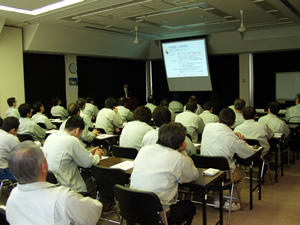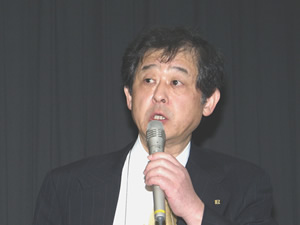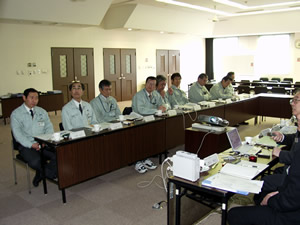|
|
 |
|
|
The 94th Safety Caravan was conducted at Nippon Nuclear Fuel Development Co., Ltd (NFD) in Oarai-machi, Higashi Ibaraki-gun, Ibaraki Prefecture on April 19, 2007. |
| Safety Presentation |

|
|
During the Safety Presentation
|
Approximately 50 employees of Nippon Nuclear Fuel Development Co., Ltd. and workers of affiliated companies attended the lecture.
The opening salutation was given as follows:
"In our line of business, all sorts of persons engage in all sorts of tasks. At today's Safety Caravan Safety Presentation, we look forward to learning about how the human thought processes, judgment, and actions of those persons engaged in those various tasks relate to the occurrence of problems, and what we can do to prevent errors from occurring.
"Also, at our request, examples of good practices in preventive maintenance will be discussed in the Safety Information Exchange Session. As it has been 30 years since we started business operations in this facility here at this location, we have taken up the implementation of countermeasures against the aging of our equipment and machinery as one of our management challenges. Another important theme is the passing on of technical prowess with the change of generations. We are also looking forward to today's information exchange to serve as a useful reference from that perspective.
"As we always say, our company's business stance is to possess the world's top level technological prowess, to be able to put out the outputs that meet customers' expectations, and to operate our facility safely, which is what earns us the support and understanding we receive from the local residents that allows us to continue operating our business at this same location.
"We hope everyone here today will take what we discuss and learn at today's Safety Caravan as food for thought and apply this in your regular work hereafter. We look forward to this leading to the fostering of our company's safety culture."
After these opening remarks, Mr. Naruse, one of JANTI's directors, presented an overview of our organization's activities, followed by Mr. Yasuo Horie, Associate Vice President of the Central Research Institute of Electric Power Industry (CRIEPI), in charge of Director of the Human Factors Research Center, Social Economic Research Laboratory will lecture on "Processes Leading to Accidents and Problems and their Prevention." |
Lecture highlights |

|
Mr. Yasuo Horie,
Director of the Human Factor Research Center,
|
Some of the valuable points brought up in the lecture were as follow:
● Human characteristics include the faculties of cognizance of situations (feature extraction) and imagination (creativity). While these are the superior characteristics of humans, these characteristics also lead to fallibility. Oversight and inaccurate information at the time of recognition affect decisions and lead improper actions (job performance and the like) as a result. What we have expressed as Human Factors are factors which interactively affect personnel behavior . This comes close to the general concept of PSF (Performance Shaping Factors). When we think about the factors that influence human behavior, there are, for example, working conditions, working environment, work management, organizational climate, and other factors on the inside of industry, and in addition, when we look toward external factors, regulations and the attitude or nature of society are also influential factors.
● Preventing Human Error
The definition of the term "human error" differs according to the person or organization, but the core of the definition is " behavior that is outside the bounds of the level of tolerance." Accidents and problems occur when latent dangers break through safety precautions. This process is referred to as a chain of events, and while human error and violation of rules are often the catalyst, there are also background factors. Preventive countermeasures against recurrence require first of all identifying these background factors, and then creating measures to prevent them. These measures can be made to materialize through protection layers on the human side and the hardware, so that, machine side.
● What should be done to assure safety
In order for safety to be materialized, actions that should be carried out by CEOs , managers, and workers include understanding the situation at the job site, personnel affairs, investment in safety precautions, abolition of disciplinary punishment, and the like.
|
In the questionnaire after the presentation, the following opinions were expressed.
● My recognition that familiarity breeds indifference leading to laxness in safety awareness was deepened by the easy to understand explanation of the human factor from a close-to-home viewpoint. The information in the lecture serves as a useful reference to the attitudes and ways of thinking about our endeavors and in understanding the difficulties of persons engaged in work duties, each from their own individual standpoint, of avoiding falling into a fixed pattern. There can be no end to the endeavors to prevent accidents by recognizing the existence of latent risk factors and through a variety of measures aimed at preventing error.
● In regard to the human factor, of which the questions of how to direct our efforts and the proper method of making endeavors have always been very elusive up until now, the discussion about raising the level of safety performance by giving thought to hierarchical structures through the organization, through safety management, in the organizational climate and culture, safety consciousness, and safety activities in which direct participation is not possible, and the discussion about "making excuses and letting others make excuses" for analysis of the background factors was very impressive. I appreciate this most valuable lecture. I hope our company will move forward in this direction in a calm manner with all of this information as our reference.
● Letting the concerned parties make excuses when a problem arises and then searching among the excuses for the real cause of the problem as one measure for preventing human error was an unexpected revelation like "suddenly seeing the light." Also I would like to add that I am grateful for being able to listen to this valuable lecture which has raised my own level of safety consciousness.
|
Safety information exchange session |

|
|
During the Safety information exchange session
|
| The Safety Information Exchange Session was honored by the presence of Mr. Hitokazu Miyaguchi, Deputy General Manager of the Nuclear Power Maintenance Engineering Department, Kobe Shipyard & Machinery Works, Mitsubishi Heavy Industries, Ltd., who, at the request of Nippon Nuclear Fuel Development Co., Ltd., gave a detailed presentation of the "Development and Operation of Preventive Maintenance Support Systems." After the presentation, opinions were exchanged concerning the above-mentioned endeavors. |
|
|







